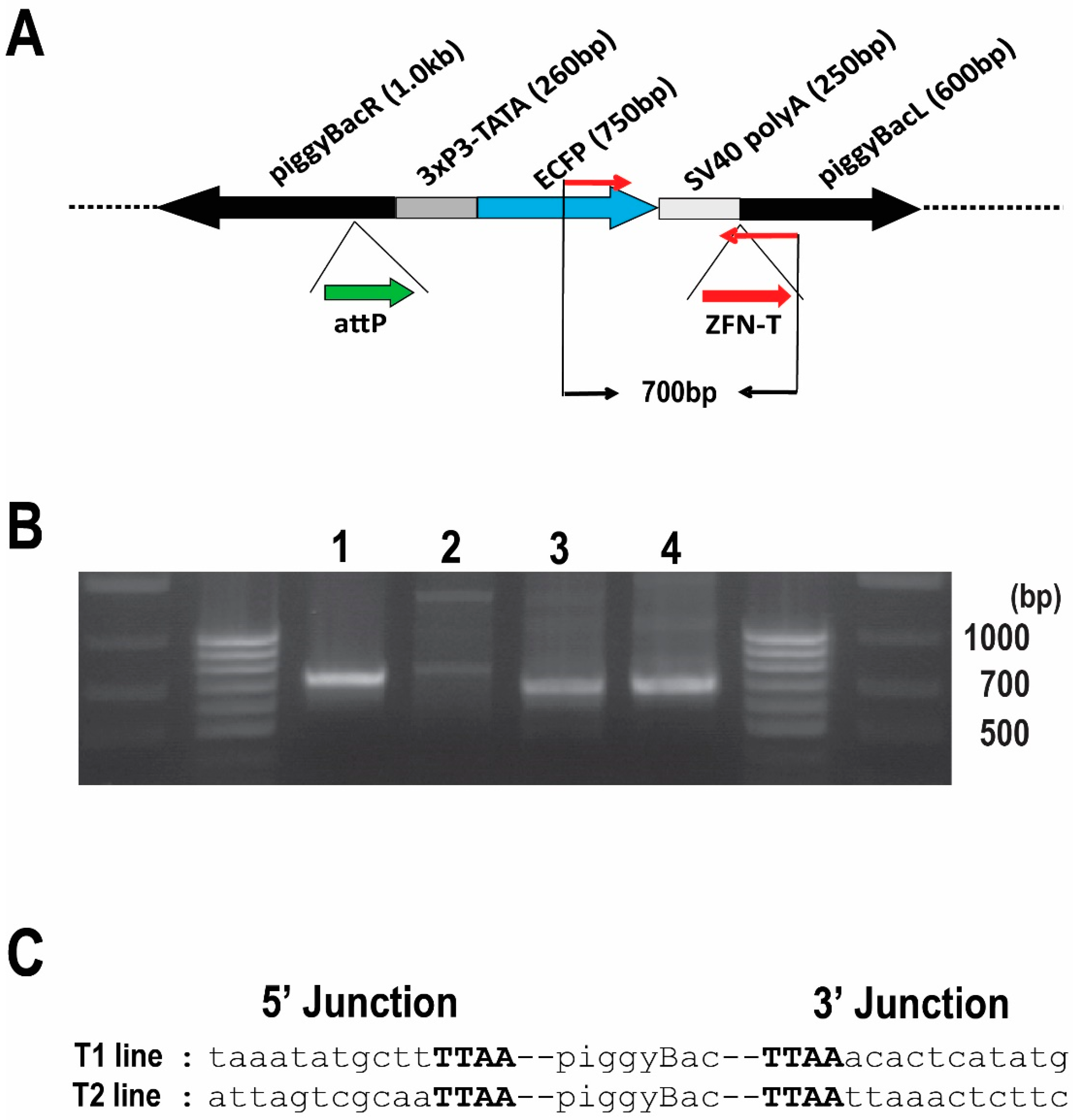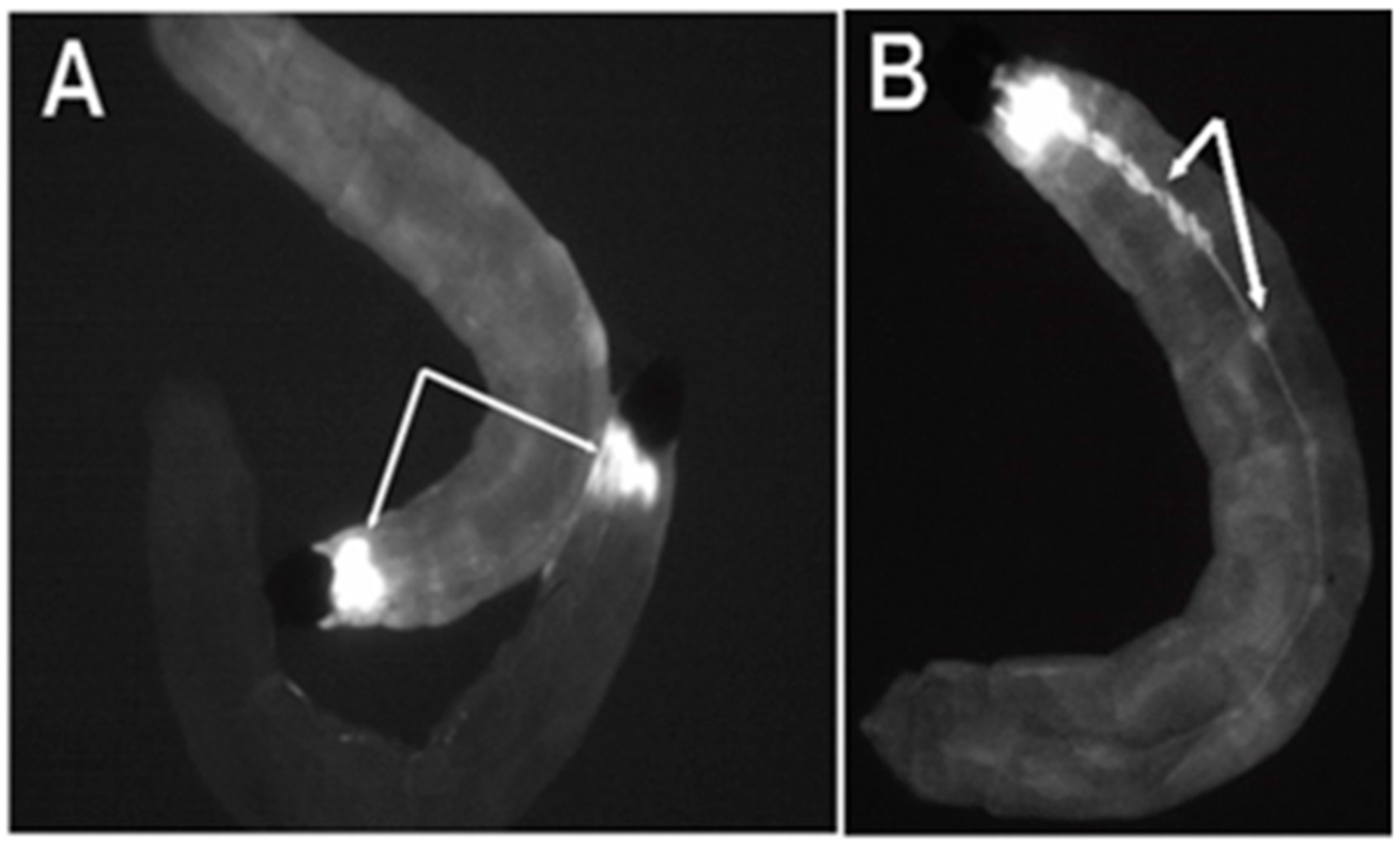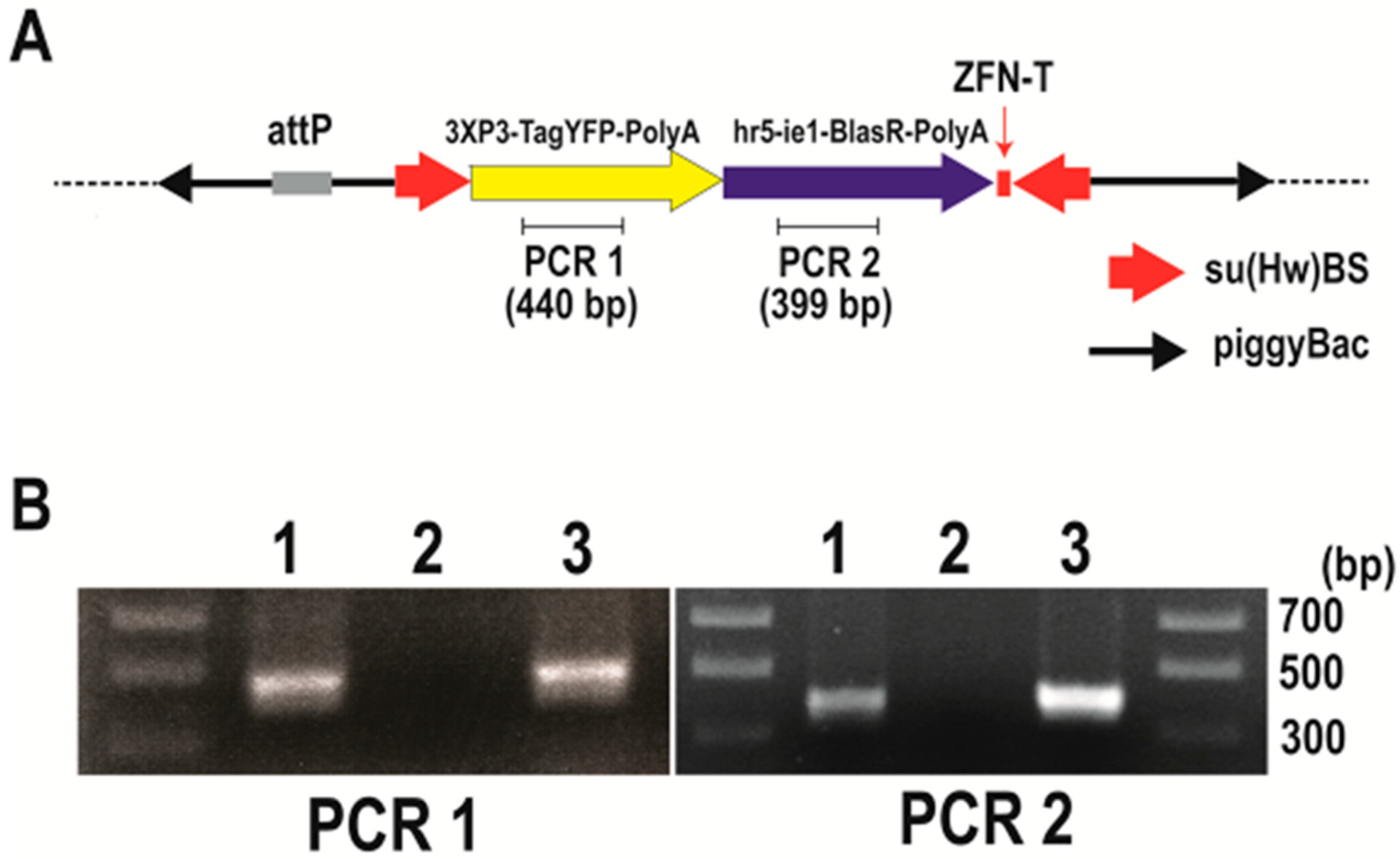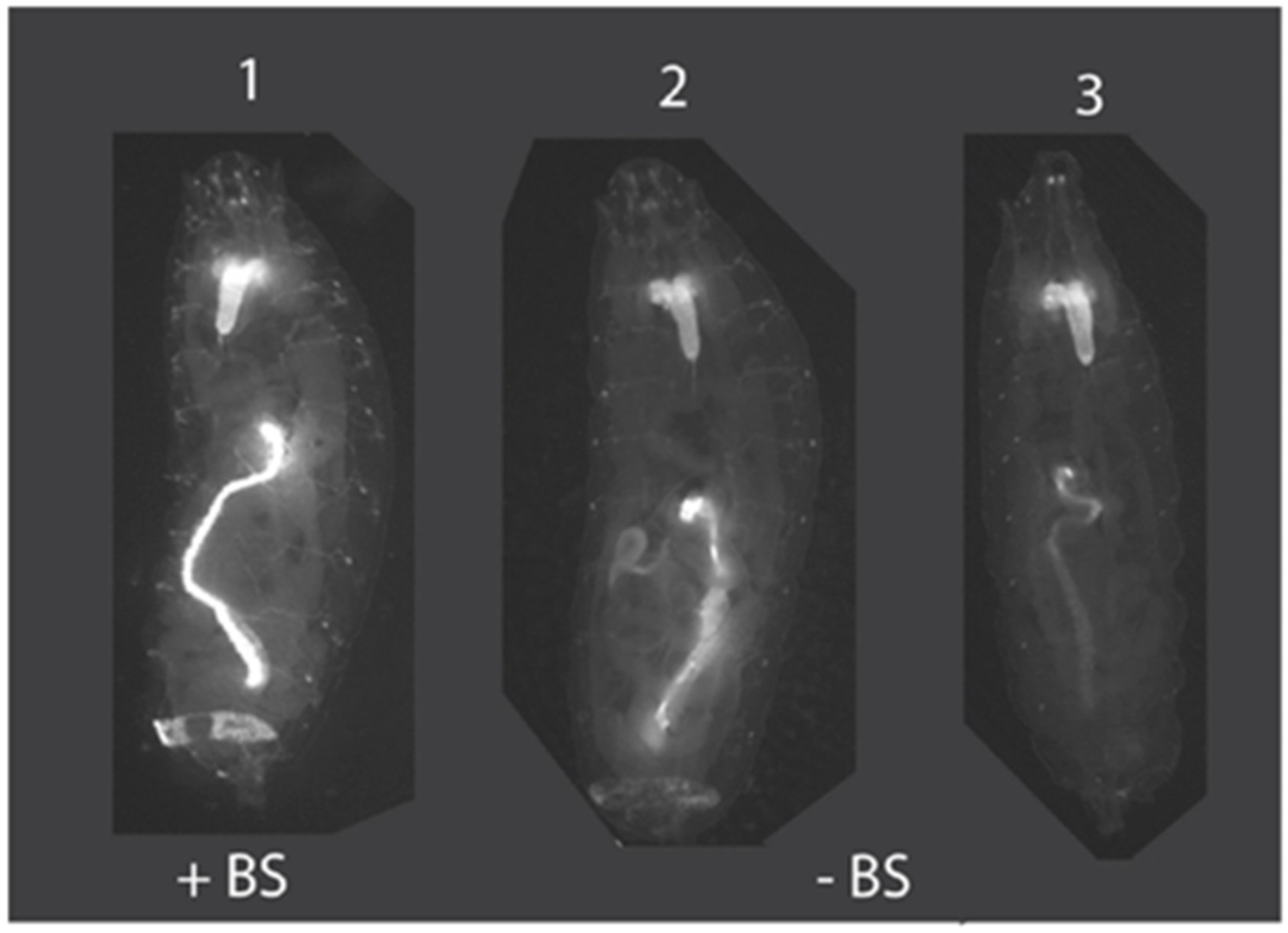Development of Transformation for Genome Editing of an Emerging Model Organism
Abstract
1. Introduction
- Locus-specific DNA amplification in larval salivary gland polytene chromosomes;
- Chromosome imprinting;
- A monopolar spindle in male meiosis I;
- Non-disjunction of the X chromosome in male meiosis II;
- Chromosome elimination in early embryogenesis;
- Germ-line-limited (L) chromosomes;
- High resistance to radiation.
2. Materials and Methods
2.1. Bradysia (Sciara) Injection
2.1.1. Egg Collection and Injection
2.1.2. Subsequent Crosses with Fluorescent Marker Selection
2.1.3. Subsequent Crosses with Antibiotic Selection
2.2. Construction of piggyBac Vectors
2.2.1. Construction of pBac [3XP3-ECFPafm] attP-ZFN-T
2.2.2. Construction of pBac [3XP3-TagYFP, hr5-ie1-BlasR, su(Hw)BS] attP-ZFN-T
2.3. PCR
2.3.1. Genomic PCR for pBac [3XP3-ECFPafm] attP-ZFN-T
2.3.2. Genomic PCR for pBac [3XP3-TagYFP, hr5-ie1-BlasR, su(Hw)BS] attP, ZFN-T
2.3.3. Inverse PCR
2.4. DNA Sequencing
3. Results
3.1. Handling Bradysia (Sciara) for Transformation
3.2. Genomic Integration of pBac [3XP3-ECFPafm] attP-ZFN-T
3.3. Genomic Integration of pBac [3XP3-TagYFP, hr5-ie1-BlasR, su(Hw)BS] attP-ZFN-T
4. Discussion
Supplementary Materials
Author Contributions
Funding
Institutional Review Board Statement
Informed Consent Statement
Data Availability Statement
Acknowledgments
Conflicts of Interest
References
- Pederson, T. An Olympian protozoan. Nucleus 2010, 1, 2–3. [Google Scholar] [CrossRef][Green Version]
- Sullivan, W. The institute for the study of non-model organisms and other fantasies. Mol. Biol. Cell. 2015, 26, 387–389. [Google Scholar] [CrossRef] [PubMed]
- Jinek, M.; Chylinski, K.; Fonfara, I.; Hauer, M.; Doudna, J.; Charpentier, E. A programmable dual-RNA-guided DNA endonuclease in adaptive bacterial immunity. Science 2012, 337, 816–821. [Google Scholar] [CrossRef] [PubMed]
- Mali, P.; Esvelt, K.; Church, G. Cas9 as a versatile tool for engineering biology. Nat. Methods 2013, 10, 957–963. [Google Scholar] [CrossRef] [PubMed]
- Esvelt, K.; Smidler, A.; Catteruccia, F.; Church, G. Concerning RNA-guided gene drives for the alteration of wild populations. eLife 2014, 17, e03401. [Google Scholar] [CrossRef] [PubMed]
- Meigen, J.W. Versuch einer neuen Gattungs Einheilung der europäischen zweiflügligen insekten. Mag. Insecktenk. 1803, 2, 259–281. [Google Scholar]
- Steffan, W.A. A generic revision of the family Sciaridae (Diptera) of America north of Mexico. Univ. Calif. Publ. Entomol. 1966, 44, 1–77. [Google Scholar]
- Gerbi, S.A. Unusual chromosome movements in Sciarid flies. In Results and Problems in Cell Differentiation; Hennig, W., Ed.; Germ Line–Soma Differentiation; Springer: Berlin/Heidelberg, Germany, 1986; Volume 13, pp. 71–104. [Google Scholar]
- Gerbi, S.A.; Urnov, F.D. Differential DNA replication in insects. In DNA Replication in Eukaryotic Cells; DePamphilis, M.L., Ed.; Cold Spring Harbor Laboratory Press: Cold Spring Harbor, NY, USA, 1996; pp. 947–969. [Google Scholar]
- Gerbi, S.A.; Strezoska, Z.; Waggener, J.M. Initiation of DNA replication in multicellular eukaryotes. J. Struct. Biol. 2002, 140, 17–30. [Google Scholar] [CrossRef]
- Gerbi, S.A. Non-random chromosome segregation and chromosome eliminations in the fly Bradysia (Sciara). Chromosome Res. 2022; in press. [Google Scholar]
- Urban, J.M.; Foulk, M.S.; Bliss, J.E.; Coleman, C.M.; Lu, N.; Mazloom, R.; Brown, S.J.; Spradling, A.C.; Gerbi, S.A. High contiguity de novo genome assembly and DNA modification analyses for the fungus fly, Sciara coprophila, using single-molecule sequencing. BMC Genom. 2021, 22, 643. [Google Scholar] [CrossRef]
- Rubin, G.M.; Spradling, A.C. Genetic transformation of Drosophila with transposable element vectors. Science 1982, 218, 348–353. [Google Scholar] [CrossRef] [PubMed]
- Handler, A.M.; Gomez, S.P.; O’Brochta, D.A. A functional analysis of the P-element gene-transfer vector in insects. Arch. Insect Biochem. Physiol. 1993, 22, 373–384. [Google Scholar] [CrossRef] [PubMed]
- O’Brochta, D.A.; Atkinson, P.W. Transposable elements and gene transformation in non-drosophilid insects. Insect Biochem. Mol. Biol. 1996, 26, 739–753. [Google Scholar] [CrossRef]
- Handler, A.M.; McCombs, S.D.; Fraser, M.J.; Saul, S.H. The lepidopteran transposon vector, piggyBac, mediates germ-line transformation in the Mediterranean fruit fly. Proc. Natl. Acad. Sci. USA 1998, 95, 7520–7525. [Google Scholar] [CrossRef]
- Handler, A.M. Use of the piggyBac transposon for germ-line transformation of insects. Insect Biochem. Mol. Biol. 2002, 32, 1211–1220. [Google Scholar] [CrossRef]
- Sarkar, A.; Sim, C.; Hong, Y.S.; Hogan, J.R.; Fraser, M.J.; Robertson, H.M.; Collins, F.H. Molecular evolutionary analysis of the widespread piggyBac transposon family and related “domesticated” sequences. Mol. Genet. Genom. 2003, 270, 173–180. [Google Scholar] [CrossRef]
- Bellen, H.J.; Levis, R.W.; He, Y.; Carlson, J.W.; Evans-Holm, M.; Bae, E.; Kim, J.; Metaxakis, A.; Savakis, C.; Schulze, K.L.; et al. The Drosophila gene disruption project: Progress using transposons with distinctive site specificities. Genetics 2011, 188, 731–743. [Google Scholar] [CrossRef]
- Cary, L.C.; Goebel, M.; Corsaro, B.G.; Wang, H.G.; Rosen, E.; Fraser, M.J. Transposon mutagenesis of baculoviruses: Analysis of Trichoplusia ni transposon IFP2 insertions within the FP-locus of nuclear polyhedrosis viruses. Virology 1989, 172, 156–169. [Google Scholar] [CrossRef]
- Fraser, M.J.; Ciszczon, T.; Elick, T.; Bauser, C. Precise excision of TTAA-specific lepidopteran transposons piggyBac (IFP2) and tagalong (TFP3) from the baculovirus genome in cell lines from two species of Lepidoptera. Insect Mol. Biol. 1996, 5, 141–151. [Google Scholar] [CrossRef]
- Fraser, M.J.; Cary, L.; Boonvisudhi, K.; Wang, H.G. Assay for movement of lepidopteran transposon IFP2 in insect cells using a baculovirus genome as a target DNA. Virology 1995, 211, 397–407. [Google Scholar] [CrossRef]
- Lobo, N.F.; Fraser, T.S.; Adams, J.A.; Fraser, M.J., Jr. Interplasmid transposition demonstrates piggyBac mobility in vertebrate species. Genetica 2006, 128, 347–357. [Google Scholar] [CrossRef] [PubMed]
- Horn, C.; Wimmer, E.A. A versatile vector set for animal transgenesis. Dev. Genes Evol. 2000, 210, 630–637. [Google Scholar] [CrossRef] [PubMed]
- Horn, C.; Jaunich, B.; Wimmer, E.A. Highly sensitive, fluorescent transformation marker for Drosophila transgenesis. Dev. Genes Evol. 2000, 210, 623–629. [Google Scholar] [CrossRef] [PubMed]
- Urnov, F.D.; Miller, J.C.; Lee, Y.L.; Beausejour, C.M.; Rock, J.M.; Augustus, S.; Jamieson, A.C.; Porteus, M.H.; Gregory, P.D.; Holmes, M.C. Highly efficient endogenous human gene correction using designed zinc-finger nucleases. Nature 2005, 435, 646–651. [Google Scholar] [CrossRef]
- Groth, A.C.; Fish, M.; Nusse, R.; Calos, M.P. Construction of transgenic Drosophila by using the site-specific integrase from phage phiC31. Genetics 2004, 166, 1775–1782. [Google Scholar]
- Yamamoto, Y.; Gustafson, E.A.; Foulk, M.S.; Smith, H.S.; Gerbi, S.A. Anatomy and evolution of a DNA replication origin. Chromosoma 2021, 130, 199–214. [Google Scholar] [CrossRef]
- Du Bois, A.M. Elimination of chromosomes during cleavage in the eggs of Sciara (Diptera). Proc. Natl. Acad. Sci. USA 1932, 18, 352–356. [Google Scholar] [CrossRef]
- Du Bois, A.M. A contribution to the embryology of Sciara (Diptera). J. Morphol. 1932, 54, 161–191. [Google Scholar] [CrossRef]
- Du Bois, A.M. Chromosome behavior during cleavage in the eggs of Sciara coprophila (Diptera) in the relation to the problem of sex determination. Zellforschung 1933, 19, 595–614. [Google Scholar] [CrossRef]
- de Saint Phalle, B.; Sullivan, W. Incomplete sister chromatid separation is the mechanism of programmed chromosome elimination during early Sciara coprophila embryogenesis. Development 1996, 122, 3775–3784. [Google Scholar] [CrossRef]
- Mohammed, A.; Coates, C.J. Promoter and piggyBac activities within embryos of the potato tuber moth, Phthorimaea operculella, Zeller (Lepidoptera: Gelechiidae). Gene 2004, 342, 293–301. [Google Scholar] [CrossRef] [PubMed]
- Patton, J.S.; Gomes, X.V.; Geyer, P.K. Position-independent germline transformation in Drosophila using a cuticle pigmentation gene as a selectable marker. Nucleic Acids Res. 1992, 20, 5859–5860. [Google Scholar] [CrossRef] [PubMed][Green Version]
- Handler, A.M.; Harrell, R.A., 2nd. Germline transformation of Drosophila melanogaster with the piggyBac transposon vector. Insect Mol. Biol. 1999, 8, 449–457. [Google Scholar] [CrossRef]
- Yusa, K.; Zhou, L.; Li, M.A.; Bradley, A.; Craig, N.L. A hyperactive piggyBac transposase for mammalian applications. Proc. Natl. Acad. Sci. USA 2011, 108, 1531–1536. [Google Scholar] [CrossRef]
- Horn, C.; Schmid, B.; Pogoda, F.S.; Wimmer, E.A. Fluorescent transformation markers for insect transgenesis. Insect Biochem. Mol. Biol. 2002, 32, 1221–1236. [Google Scholar] [CrossRef]
- Noll, M. Evolution and role of Pax genes. Curr. Opin. Genet. Dev. 1993, 3, 595–605. [Google Scholar] [CrossRef]
- Berghammer, A.J.; Klingler, M.; Wimmer, E.A. A universal marker for transgenic insects. Nature 1999, 402, 370–371. [Google Scholar] [CrossRef]
- Yamamoto, Y.; Bliss, J.; Gerbi, S.A. Whole organism genome editing: Targeted large DNA insertion via ObLiGaRe nonhomologous end-joining in vivo capture. G3 Genes Genomes Genet. 2015, 5, 1843–1847. [Google Scholar] [CrossRef][Green Version]
- Delidakis, C.; Kafatos, F.C. Amplification of a chorion gene cluster in Drosophila is subject to multiple cis-regulatory elements and to long-range position effects. J. Mol. Biol. 1987, 197, 11–26. [Google Scholar] [CrossRef]
- Delidakis, C.; Kafatos, F.C. Amplification enhancers and replication origins in the autosomal chorion gene cluster of Drosophila. EMBO J. 1989, 8, 891–901. [Google Scholar] [CrossRef]
- Gerasimova, T.I.; Corces, V.G. Chromatin insulators and boundaries: Effects on transcription and nuclear organization. Annu. Rev. Genet. 2001, 35, 193–208. [Google Scholar] [CrossRef] [PubMed]
- Geyer, P.K.; Corces, V.G. DNA position-specific repression of transcription by a Drosophila zinc finger protein. Genes Dev. 1992, 6, 1865–1873. [Google Scholar] [CrossRef] [PubMed]
- Corces, V.G. Keeping enhancers under control. Nature 1995, 376, 462–463. [Google Scholar] [CrossRef] [PubMed]
- Mallin, D.R.; Myung, J.S.; Patton, J.S.; Geyer, P.K. Polycomb group repression is blocked by the suppressor of Hairy-wing [su(Hw)] insulator. Genetics 1998, 148, 331–339. [Google Scholar] [CrossRef] [PubMed]
- Zorin, I.D.; Gerasimova, T.I.; Corces, V.G. The lawc gene is a new member of the trithorax-group that affects the function of the gypsy insulator of Drosophila. Genetics 1999, 152, 1045–1055. [Google Scholar] [CrossRef]
- Lu, L.; Tower, J. A transcriptional insulator element, the su(Hw) binding site, protects a chromosomal DNA replication origin from position effects. Mol. Cell. Biol. 1997, 17, 2202–2206. [Google Scholar] [CrossRef]
- Lu, L.; Zhang, H.; Tower, J. Functionally distinct, sequence-specific replicator and origin elements are required for Drosophila chorion gene amplification. Genes Dev. 2001, 15, 134–146. [Google Scholar] [CrossRef][Green Version]
- Zhang, H.; Tower, J. Sequence requirements for function of the Drosophila chorion gene locus ACE3 replicator and ori-β origin elements. Development 2004, 131, 2089–2099. [Google Scholar] [CrossRef]
- Sarkar, A.; Atapattu, A.; Belikoff, E.J.; Heinrich, J.C.; Li, X.; Horn, C.; Wimmer, E.A.; Scott, M.J. Insulated piggyBac vectors for insect transgenesis. BMC Biotechnol. 2006, 6, 27. [Google Scholar] [CrossRef]




Publisher’s Note: MDPI stays neutral with regard to jurisdictional claims in published maps and institutional affiliations. |
© 2022 by the authors. Licensee MDPI, Basel, Switzerland. This article is an open access article distributed under the terms and conditions of the Creative Commons Attribution (CC BY) license (https://creativecommons.org/licenses/by/4.0/).
Share and Cite
Yamamoto, Y.; Gerbi, S.A. Development of Transformation for Genome Editing of an Emerging Model Organism. Genes 2022, 13, 1108. https://doi.org/10.3390/genes13071108
Yamamoto Y, Gerbi SA. Development of Transformation for Genome Editing of an Emerging Model Organism. Genes. 2022; 13(7):1108. https://doi.org/10.3390/genes13071108
Chicago/Turabian StyleYamamoto, Yutaka, and Susan A. Gerbi. 2022. "Development of Transformation for Genome Editing of an Emerging Model Organism" Genes 13, no. 7: 1108. https://doi.org/10.3390/genes13071108
APA StyleYamamoto, Y., & Gerbi, S. A. (2022). Development of Transformation for Genome Editing of an Emerging Model Organism. Genes, 13(7), 1108. https://doi.org/10.3390/genes13071108






